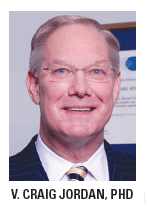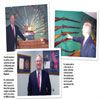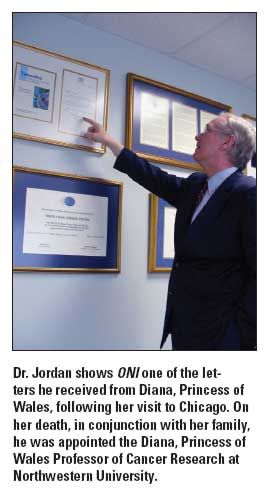Masters of hematology and oncology: Father of tamoxifen a Brit to the core
V. Craig Jordan, OBE, PhD, DSc, widely known as “The Father of Tamoxifen,” collects the artifacts of war: guns and swords and medals (see photographs).

V. Craig Jordan, OBE, PhD, DSc, widely known as “The Father of Tamoxifen,” collects the artifacts of war: guns and swords and medals (see photographs). In fact, in his younger years, he served in the elite SAS (Special Air Service) unit of the British Army. Speaking with ONI at his office at Fox Chase Cancer Center in Philadelphia, Dr. Jordan reminisced about his maternal grandfather, an old army officer who railed against the evils of war, but told young Craig to be prepared-war will come again.
Sitting below a picture of himself and Princess Diana, Dr. Jordan cocked his wrist, offering the regimental motto on his cufflinks: “Who Dares Wins.”
“I was born in New Braunfels, Texas, in 1947 to an American father from Dallas and an English mother. Their marriage didn’t last, and my mother took me back to Cheshire, England,” Dr. Jordan said. Cheshire, a rural county of verdant hills in northwest England, is where Dr. Jordan’s mother grew up; her lineage in the region reaches back to the 12th century.
If being uprooted from the brash heat of Texas to the mossy remnants of heraldic England was unsettling, Dr. Jordan gave no hint of it. In fact, he relished the opportunity of dual nationality, after being adopted by his English stepfather, from whom he took the name Jordan.
By the age of 12, Craig Jordan was fascinated by chemistry. “My mother let me set up my bedroom as a chemistry laboratory. I had free access to my school’s lab, and the town pharmacist sold me whatever agents or chemicals I wanted. Of course, nothing I was doing would be allowed today,” he said with a laugh.
In his pursuits, the young chemist set the curtains ablaze, killed the family lawn, then turned it bright blue with an experiment designed to revive it to its natural green. Caution aside, there was an underlying motive to his breakneck explorations.
“I had a passion to use chemical reactions to synthesize medicines. By the time I was 17, I was solidifying my ideas around the possibilities of science,” Dr. Jordan said. He reflected a moment and said, “But still, I wasn’t certain that I wanted to go to the university.”
A grandfather’s influence
Dr. Jordan’s grandfather was an officer in both world wars. He described him as a forthright person, born of a different age-a great influence on a young man chasing dreams. Listening to Dr. Jordan you can picture his grandfather’s stiff upper lip, the rock-solid chin.

“We would go to his house for Sunday lunch. There were bayonets on the hearth, a pistol that had been hand-made for him during the First World War, target rifles. He was a crack shot! You knew where you stood with my grandfather. He was for the Empire. He had seen it come and go,” Dr. Jordan said.
The ghosts of his military heritage tugged at Craig Jordan, but there was a deep family history of medicine as well. “My forebears on the Jordan side had founded Manchester Medical Center, the first medical school outside of London,” Dr. Jordan said.
But he was not convinced he wanted an academic career. After all, the army beckoned. “I came from a family that believed in service to country and using the tools you have to make things better,” Dr. Jordan said. However, his effort to join the British army was stymied by an incidental factor-he wasn’t born in any part of the Empire; he was born in America.
In those years in Britain, only 4% of secondary school students went on to university. But Craig Jordan wasn’t just any student-he had already been teaching biochemistry at the university level at his boy’s school-and he was encouraged to apply for university. The headmaster’s letter of recommendation was emphatic, starting out, “Craig Jordan is an unusual young man, A VERY UNUSUAL YOUNG MAN.” He was accepted at the University of Leeds.
Looking for a path
Craig Jordan finished top in his class at Leeds, excelling in organic and biochemistry.
“Everything looked rosy, except I didn’t know how to pursue the things that fascinated me,” he said. He considered the pharmaceutical industry, where “they would actually pay me to synthesize drugs,” but decided, instead, to pursue a PhD in pharmacology at Leeds.
“In the summer of 1967, I worked at ICI Pharmaceuticals near my home. I worked with Dr. Steven Carter who headed the anticancer screening program. Across the hall, Dr. Arthur Walpole, head of Reproduction Research, had just published work on a new antiestrogen, ICI 46,474, as a rat contraceptive,” he said.
Hopes were high that the antiestrogen could be developed into a contraceptive for humans. Coincidentally, Dr. Jordan chose to do his PhD work on antiestrogens.
Service calls
Not too long after starting his PhD program, an army career at last became a possibility: The Jordan’s family counsel convinced the Ministry of Defence that there were no grounds to exclude Craig Jordan from voluntary service, and he was commissioned into the army as an infantry officer.
“I didn’t really want to be an infantry officer. I needed something more exciting. So I thought I would try the intelligence corps,” Dr. Jordan said.
He went to headquarters and an officer approached him indifferently, asking why he wanted to join the regular army intelligence corps. “I said, no, I’m a scientist doing my PhD. Maybe the reserve intelligence corps. . .”
Indifference quickly changed to enthusiasm, and he was whisked off for an interview with the Deputy Chief Scientist with the Ministry of Defence.
“I was told if I passed all the security screening I would be a captain in the intelligence corps,” Dr. Jordan said. He did, and because of his scientific background, the newly appointed Captain Jordan became the lead expert in nuclear, chemical, and biological warfare, to be inserted along the Rhine in strategic exercises.
“If Russians ever came across the border, I was supposed to diagnose the situation and tell my command what was going on with the weaponry and so forth,” he said. Smiling over the irony, he added, “Three years before, I was dismissed as a foreigner; then all of a sudden I was guarding the Holy Grail!”
Being in the reserves allowed Dr. Jordan to move back and forth between his army service and the university. He received a scholarship from the Medical Research Council allowing him to complete his PhD in pharmacology, looking at the structural relationships of antiestrogens.
There was, however, one problem; the department couldn’t find anyone to be his examiner.
Enthusiasm for antiestrogens had cooled when researchers failed to produce a marketable “morning after” contraceptive pill. At that time, “no one gave a damn about failed contraceptives and antiestrogens,” Dr. Jordan commented.
Finally, the university engaged Dr. Walpole, the original antiestrogen investigator, to review Jordan’s PhD.
“We really hit it off,” Dr. Jordan said. During discussions about using antiestrogens to treat breast cancer, he said, an idea was formed: Why don’t we use the estrogen receptor as a target?
Back to the States
By then, ICI Pharmaceuticals had given up on ICI 46,474 as a contraceptive, but the drug had shown modest activity in preliminary studies in metastatic breast cancer. With the support of Dr. Walpole and the Worcester Foundation, Dr. Jordan crossed the Atlantic to join the Foundation’s lab in Massachusetts and gain needed experience with laboratory models in breast cancer.
Meanwhile, ICI had just acquired a company in the United States, and Dr. Jordan made his way to their Delaware headquarters, the new home of ICI 46,474, now called tamoxifen.
“I was introduced to Ms. Lois Trench, ICI’s clinical drug monitor for tamoxifen,” Dr. Jordan said, describing her as “full of energy and drive.”
She arranged for Dr. Jordan to study the interaction of tamoxifen with the estrogen receptor. Then there were papers and lectures, followed by more papers and more lectures. Dr. Jordan said he was never pursued by the demons of haste, because “there was still no real interest in the drug.” But his enthusiasm never flagged, and since 1974, he has not stopped lecturing or writing about tamoxifen, which, of course, became a mainstay in the adjuvant treatment of breast cancer.
Back to the past
Dr. Jordan ended his visit with ONI with a drive to his home in the leafy suburb of Fox Chase, where he began what is commonly referred to as “the tour.”
Meticulously mounted on the walls of the house are long-guns and swords that dramatize the bloody, noble, misled, victorious, and doomed campaigns of the British Empire. In the library, he touched a rifle and said, “This is a Martini-Henry .45 caliber, the same model used in 1879 at Isandhlwana, where the Brits were overcome by the Zulus.”
Stopping at mounted crossed swords, a gift from Wilkinson Sword, Dr. Jordan noted the inscribed names of his doctoral students on the chrome scabbard. “My students learned about tamoxifen, but they also learned how the Israelis won the Six Day War,” he said. Aside from the antique weaponry, there’s a place on the wall for Dr. Jordan’s personal coat of arms. Pointing to it he said, “My personal motto is ‘Strength Through Knowledge.’”
Dr. Jordan continues his work on antiestrogens at Fox Chase, where he is vice president and scientific director for Medical Science and holds the Alfred G. Knudson, Jr., Chair in Cancer Research. He is being honored at this year’s ASCO annual meeting with the David A. Karnofsky Memorial Award and Lecture.

If scientific work is a building block, then Dr. Jordan’s shoulders are there for the next generation of scientists to stand on. To Dr. Jordan, his life’s work all boils down to service: to country and to science.
CAREER HIGHLIGHTS
1969-1972
Began studying the estrogen receptor at University of Leeds with Dr. Edward Clark. In 1972, became a visiting scientist at the Worcester Foundation of Experimental Biology.
1974-1979
On faculty of University of Leeds. Conducted first successful lab studies of ICI 46, 474 as a breast cancer preventive, establishing the scientific basis of antiestrogens; ICI 46,474 became tamoxifen.
1980-1993
After a year at the Ludwig Institute for Cancer Research, joined the University of Wisconsin-Madison where he started to look at the effects of tamoxifen and raloxifene on bone density and coronary systems. Appointed Professor of Human Oncology 1986.
1993-2004
Director of the Breast Cancer Research Program, Robert H. Lurie Comprehensive Cancer Center of Northwestern University.
In 1999, became Diana, Princess of Wales Professor of Cancer Research at Northwestern University Medical School. In 2002, named an Officer of the Most Excellent Order of the British Empire by Queen Elizabeth II.
2005
Appointed Alfred G. Knudson, Jr., Chair of Cancer Research at Fox Chase. His paper The effect of raloxifene on risk of breast cancer in postmenopausal women: Results from the MORE randomized trial one of the top 20 most cited breast cancer papers during 2003 and 2004.
Newsletter
Stay up to date on recent advances in the multidisciplinary approach to cancer.